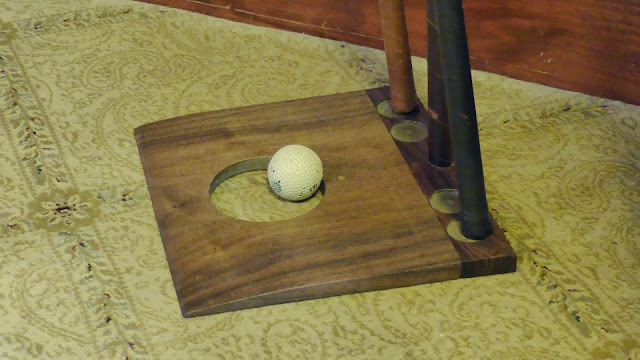Vintage Golf Club Display Stand
The construction for this golf club display stand was partly inspired by the design of an old long nose golf club.
From the earliest days of golf history to the late 19th century, the slender wooden golf club heads were attached to their shaft using a scare joint. This is simply an oblique cut made in both the shaft and neck of the clubhead to provide more surface area for gluing and attaching the whipping.
 |
| Red line shows the scare joint |

This same joint is commonly used in timber frame construction to attach two beams together end to end. In woodworking and outside of Scotland, the joint is called a scarf joint.
So that the supporting club shaft could be placed through a hole in the top rack of this display stand, the shaft was cut obliquely at its narrowest point with the two ends wedged together within the hole and glued.
 |
| The red line shows the glued up scarf joint |
This stand was created from a walnut log that was milled on the band saw.
Here are some key details:
- The angle for the round mortise to house the support club was kept in check by placing a sliding bevel while drilling.
- To prevent cupping of the board that contains the golf hole, a breadboard clamp was made along the back part. A breadboard clamp consists of three tenons along the main piece that fit into three mortises of the cross-grained rear rail.
- Holes to accommodate the butt end of the golf club were made with Forstner bits
- The decorative string inlay lines along the curves were set in using a marking gauge. The smaller diameter brass guide followed the curves well enough. This was followed by making a deeper groove with a marking knife and finally making a groove with a Veritas Template Groove Cutter. The light colored ash strips, cut on the band saw and thinned down to the correct width with a hand plane and spokeshave, were glued and placed into the grooves. The thin strips did not have a problem making the curves. Once the glue cured, the string inlay was planed down with a miniature block plane.
- The club used for this project had a substantial diagonal crack in the shaft near the thin part of the shaft that had been previously repaired with glue and golf shaft whipping string, a natural scarf joint. The faces of this joint were smoothed and the two parts of the shaft were inserted through the angled hole in the top rack and glued. After the glue dried, I could not figure out initially why the stand was so unstable. Then I looked at the shaft and realized that there were 2 more cracks in the shaft. Oh #*&$!. This thing was already glued. No turning back. The only solution was to bisect/cut the shaft at the unstable part and drill long holes in the center of the shaft to accommodate a dowel. It was still a bit unstable, so I added 1/2" copper pipe that was hack-sawed longitudinally and secured with pipe clamps. An oval initials logo was carved out and secured over the repair site. Lemonade from lemons.
- The butt end of the handle was further secured by making a saw kerf cut on the butt end. The club was fitted into the round mortise and the wedge was the hammered into the shaft.
 |
| Arrows denote location of thin wedge that was driven into butt end of club to tighten the joint. |














Comments
Post a Comment